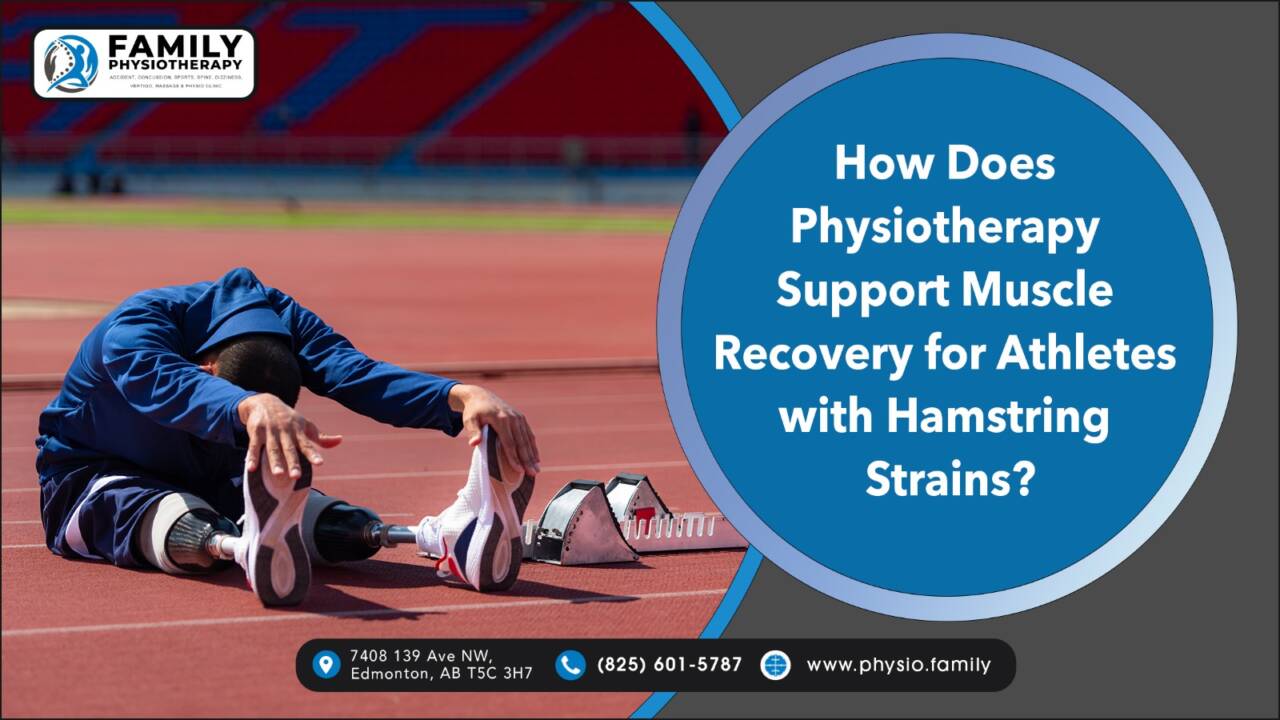HEALTH
How Does Physiotherapy Support Muscle Recovery for Athletes with Hamstring Strains

Sports physiotherapy focuses on the prevention, assessment, treatment, and rehabilitation of sports-related injuries. Sports physiotherapists collaborate with athletes of all ages and levels, from recreational enthusiasts to professional athletes, to aid in their recovery from injuries, improve performance, and prevent future injuries. Sports physiotherapy in Edmonton helps athletes recover from injuries, optimize performance, and stay healthy and active in their chosen sports.
Let us look into how physiotherapy aids in muscle recovery for athletes with hamstring strains.
Sports physiotherapy in Edmonton plays a crucial role in supporting muscle recovery for athletes with hamstring muscle injuries by employing a combination of techniques aimed at reducing pain, promoting healing, restoring flexibility, and rebuilding strength. Here’s how physiotherapy supports muscle recovery for athletes with hamstring strains:
Pain Management:
Physiotherapists utilize various modalities such as ice therapy, heat therapy, and electrotherapy to alleviate pain and inflammation in the injured hamstring. Pain management techniques help improve comfort levels, allowing athletes to engage more effectively in the rehabilitation process. Sports physiotherapy employs various hamstring strain treatments for athletes, including:
Electrotherapy:
Modalities such as ultrasound, transcutaneous electrical nerve stimulation (TENS), or interferential current (IFC) can be utilized to offer pain relief and enhance tissue healing through electrical stimulation.
Manual Therapy:
Hands-on techniques like massage, soft tissue mobilization, and joint mobilizations may be employed to reduce muscle tension, improve tissue flexibility, and alleviate pain. These techniques include:
Active Release Techniques (ART): This manual therapy technique involves the application of deep pressure and movement to specific areas of the hamstring muscles to disrupt scar tissue, adhesions, and trigger points. ART helps restore normal muscle function and range of motion, facilitating recovery from hamstring strains.
Muscle Energy Techniques (MET): MET involves the active participation of the athlete in resisted movements performed against the therapist’s resistance. These techniques help improve muscle strength, flexibility, and neuromuscular control in the hamstring muscles, promoting faster recovery and preventing re-injury.
Restoring Range of Motion:
Sports physiotherapy in Edmonton incorporates stretching exercises and manual therapy techniques to restore flexibility and mobility in the hamstring muscles. Gentle stretching helps prevent the formation of scar tissue and promotes the realignment of muscle fibres, promoting ideal optimal healing and reducing the risk of re-injury.
Active Isolated Stretching (AIS):
AIS involves performing repetitive, isolated stretching exercises targeting specific muscle groups, including the hamstrings. Athletes actively contract and relax the hamstring muscles while moving through a controlled range of motion to improve flexibility and reduce stiffness.
Foam Rolling:
Athletes use a foam roller to perform self-myofascial release techniques on the hamstring muscles, applying pressure to alleviate tension and adhesions in the soft tissues. Foam rolling helps improve flexibility, reduce muscle tightness, and enhance overall mobility in the hamstrings.
Strengthening Exercises:
Progressive strengthening exercises are introduced to gradually rebuild the strength and stamina of the hamstring muscles. Physiotherapists design customized exercise programs that target the hamstring muscle group, as well as surrounding muscles that support hip and knee stability. Strengthening exercises help improve muscle function and reduce the likelihood of future strains. A strengthening exercise used in sports physiotherapy:
Romanian Deadlifts:
This exercise primarily targets the hamstrings and lower back. The athlete stands with feet hip-width apart, holding a barbell or dumbbell at the anterior thighs. Keeping the back straight, they pivot at the hips, lowering the weight towards the floor while maintaining a slight bend in the knees.
Glute Bridges:
While primarily targeting the gluteal muscles, this exercise also engages the hamstrings. The athlete lies on their back with knees bent and feet flat on the ground. They then lift their hips towards the ceiling, squeezing the glutes and engaging the hamstrings.
Functional Rehabilitation:
Physiotherapists implement functional rehabilitation exercises that mimic real-life movements and activities relevant to the athlete’s sport. This may include dynamic exercises such as lunges, squats, and single-leg balance activities, which challenge the hamstring muscles in a sport-specific context while improving overall neuromuscular control and coordination.
Squat Variations:
Squats are fundamental functional exercises that target the lower body, including the hamstrings, quadriceps, and glutes. Variations such as sumo squats, split squats, and pistol squats can be incorporated to challenge balance, strength, and coordination.
Plyometric Exercises:
Plyometric exercises involve explosive movements that improve power, agility, and coordination. Examples include box jumps, jump squats, and bounding exercises, which engage the hamstrings while simulating the dynamic movements required in sports.
Proprioceptive Training:
Proprioception refers to the body’s ability to sense its position in space and is crucial for injury prevention and athletic performance. Physiotherapy includes proprioceptive training exercises that focus on improving balance, coordination, and proprioceptive awareness in the injured hamstring. Proprioceptive training helps reduce the risk of re-injury by enhancing joint stability and control.
Proprioceptive Taping:
Applying kinesiology tape in specific patterns over the injured hamstring can provide proprioceptive feedback, enhancing joint awareness and stability. The tension from the tape stimulates the skin receptors, which relay information about joint position and movement to the brain.
Eccentric Strengthening with Proprioception:
Eccentric exercises, where the muscle elongates under tension, can be combined with proprioceptive challenges to improve control and strength in the hamstring. Examples include eccentric single-leg squats or eccentric hamstring curls on a stability ball.
Empowering Athletic Rehabilitation:
Family physiotherapy in Edmonton plays a crucial role in the comprehensive management of athletes recovering from hamstring strains. By addressing muscle imbalances, enhancing neuromuscular control, and improving proprioceptive awareness, athletes can regain confidence in their abilities and safely return to sport at their pre-injury level.
However, it’s essential to recognize that rehabilitation is a personalized journey, and each athlete may require tailored sports injury physiotherapy interventions based on their specific needs, goals, and sport-specific demands. With the guidance and expertise of sports physiotherapists, athletes can navigate the rehabilitation process effectively, ultimately achieving optimal performance and long-term athletic success.
e










